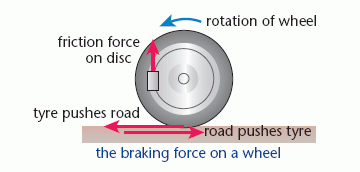Forces & Braking
Vehicles that travel on wheels rely on friction between the tyres and the road surface to provide the driving force. Ice on a road surface and wet leaves on railway lines can reduce the friction force, resulting in the wheels spinning round as they slide over the surface.
Friction is also used in braking systems to bring cycles and motor vehicles to a halt. Two common types of brake used are drum brakes and disc brakes. These are shown in the diagram.

Most modern vehicles use disc brakes because of their greater efficiency.
When the driver applies the brakes, high friction material in the shoe or pad is pressed against the drum or disc. The friction force exerts a torque in the opposite direction to the torque that drives the wheel. During braking the tyre pushes forwards on the road surface, causing the road surface to push backwards on the tyre. The resultant force in the backwards direction causes the vehicle to decelerate.

A deceleration is a negative acceleration. In this case the acceleration is in the opposite direction to the vehicle’s velocity, so it has the opposite sign.
Braking forces, like driving forces, rely on friction. The size of the friction force depends on the nature of both the road and the tyre surface. The greater the friction force, the shorter the distance required to stop the vehicle.
Grand prix drivers match their tyres to the road conditions. Excessive friction wastes fuel and reduces the acceleration and top speed. However, having fitted tyres suitable for dry road conditions, a sudden shower of rain can suddenly send the cars out of control!
Tyre tread is designed to prevent a layer of water building up between the tyre and the road. This reduces the friction force, reducing the effectiveness of steering, drive and braking. If there is insufficient tread on a tyre it cannot push the water out of the way quickly enough, as the channels in the tyres are too small for all the water to pass through.
